

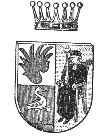 |
|
 |
Rittmeister Manfred Albrecht Freiherr von Richthofen
Manfred von Richthofen was born on May 2, 1892 in Breslau, Germany (now Wroclaw Poland).
He died on April 21, 1918 in the skies over Vaux sur Somme, France. He was 25 years old.
He was called der rote Kampfflieger (The Red Battle-Flyer) by his own people, le petit
rouge by the French, and the Red Baron by the English. In a time of wooden and fabric
aircraft, when twenty air victories insured a pilot legendary status and the coveted Pour
Le Mérite, Richthofen had eighty victories, and is regarded to this day as the ace of
aces.
Manfred von Richthofen was born the son of Major Albrecht von Richthofen, a Prussian
nobleman and his wife, Kunigunde. (The name Richthofen means "court of
judgement" and was bestowed by the Holy Roman Emperor Leopold I.) Manfred was the
eldest of three sons (the eldest child was his sister, Ilse). He was enrolled at age 11 at
the military school at Wahlstatt, and then attended the Royal Military Academy at
Lichterfelde. Manfred was a far better athlete than he was a scholar, and applied his
horseback riding skills to become a cavalry officer. He was commissined in April, 1911 in
the 1st Regiment of Uhlans Kaiser Alexander III. He was promoted to Leutnant in 1912.
Unfortunately, twentieth century warfare had little use for mounted cavalry. The invention
of the machine gun had led to the need for combat operations to be carried out from
trenches dug into the country side. When war broke out in August, 1914, Richthofen looked
to the air service for a new challenge. He initially joined the Fliegertruppe (air
service) in 1915 as an observer because the training course was shorter and would get him
to combat faster. After meeting Oswald Boelcke, who would remain his hero and idol,
Manfred was committed to becoming a pilot. After only 24 hours of flight training from his
friend, Oberleutnant Georg Zeumer, he made his first solo flight on October 10, 1915. (He
crashed his plane attempting to land.)
1915
September - In his second air combat (still as an observer), Richthofen exchanges fire
with a French plane. The Allied plane dropped away and crashed, but Richthofen was not
credited with the victory as the enemy plane crashed behind French lines (and could
therefore not be confirmed). Later in his career, Richthofen would not be held to this
restriction: he was taken at his word for his kills.
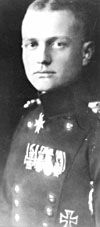 1916
1916
Apr 24 - Richthofen shoots down his first plane as a pilot. The craft, a French Nieuport,
crashed behind enemy lines, and again the victory was not officially credited to
Richthofen.
Sep 1 - At Oswald Boelcke's invitation, Richthofen reports for duty on the Western Front.
He begins his career with Jagdstaffel 2 in an Albatros D.II biplane. Although it was the
Fokker Dr.I triplane with which Richthofen is remembered, he spend the vast majority of
his time flying biplanes like the Albatros D.II and D.III.
Sep 17 - Richthofen scores his first confirmed air victory.
October: After 40 victories, Oswald Boelcke is killed in a mid-air collision during
combat. Some accounts blame Richthofen's enthusiasm for the collision which caused pilot
Erwin Böhme's undercarriage to collide with Boelcke's upper wing. Others place the blame
on Böhme, or simply an accident not attributable to anyone.
Nov 23 -- Richthofen, with the help of a superior aircraft, makes British ace Major Lanoe
Hawker his eleventh victim.
1917
Jan 4 -- Richthofen scores his 16th air victory, making him the top living German ace. On
January 12th, Richthofen receives the Orden Pour le Mérite (the "Blue Max"). He
is given command of Jasta 11. Richthofen decides to paint parts of his aircraft red, in
part to identify himself easily to his allies on the ground (whom he feared would
otherwise shoot at him). It has been suggested that he chose red because it was the color
of his old Uhlan cavalry regiment. This begins a series of traditions: each plane in his
squadron begins to display some red coloring to show solidarity. Later in the war, some
British planes bore red noses, announcing their intentions of hunting down the red baron.
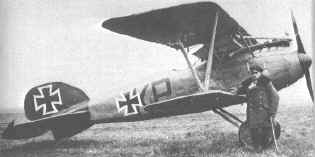 Jan 24 -- The lower wing of Richthofen's Albatros D.III breaks off in
flight (a common problem for that type).
Jan 24 -- The lower wing of Richthofen's Albatros D.III breaks off in
flight (a common problem for that type).
Mar 9 -- Richthofen is shot down over Oppy, but was flying again the same day.
Apr 7 -- Richthofen is promoted to Rittmeister (Cavalry Captain)
Apr 8 -- The lower wing of the Albatros D.III flown by another member of Jasta III breaks
off in flight. Richthofen writes an angry letter to Berlin, and is visited by aircraft
designer Anthony Fokker, who literally goes to the trenches to observe aircraft. The
result of this visit (in which he was able to observe the British Sopwith Triplane) led to
Fokker's development of the Dr.I triplane.
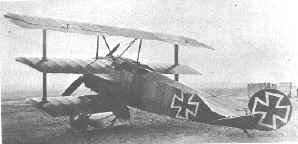 Apr 29 -- Richthofen shoots down four planes in one day, a personal best.
April, 1917 is known as "Bloody April". Britain lost 912 pilots and observers
during the month, while Richthofen scored an incredible 21 victories during the same
period. After his 41st victory, Richthofen was ordered on leave. Turning command over to
his brother Lothar, Manfred left the front on May 1st and did not return until early June.
He spent his vacation hunting in his home town, on propoganda tours, and meeting with
Kaiser Wilhelm.
Apr 29 -- Richthofen shoots down four planes in one day, a personal best.
April, 1917 is known as "Bloody April". Britain lost 912 pilots and observers
during the month, while Richthofen scored an incredible 21 victories during the same
period. After his 41st victory, Richthofen was ordered on leave. Turning command over to
his brother Lothar, Manfred left the front on May 1st and did not return until early June.
He spent his vacation hunting in his home town, on propoganda tours, and meeting with
Kaiser Wilhelm.
Jun 24 -- Jagdgeschwader 1 (Fighter Wing 1) is formed, with Manfred von Richthofen in
command. The wing would later be renamed "Jagdgeschwader Frieherr von
Richthofen" in his honor.
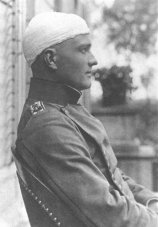 July: Richthofen is shot down by Capt. Douglas Cunnel and 2nd Lt. Albert
Woodbridge. Though he lands safely, he has suffered a serious bullet wound to the head.
Manfred would suffer from terrible headaches until the end of his life, but there were
other ramifications. German command, recognizing the propaganda value to the enemy of
Richthofen's loss, begins to pressure him to retire from air combat, going so far as to
forbid him from flying unless absolutely necessary (a loophole Richthofen exploited at
every opportunity).
July: Richthofen is shot down by Capt. Douglas Cunnel and 2nd Lt. Albert
Woodbridge. Though he lands safely, he has suffered a serious bullet wound to the head.
Manfred would suffer from terrible headaches until the end of his life, but there were
other ramifications. German command, recognizing the propaganda value to the enemy of
Richthofen's loss, begins to pressure him to retire from air combat, going so far as to
forbid him from flying unless absolutely necessary (a loophole Richthofen exploited at
every opportunity).
Richthofen began to spend more and more of his time in more administrative and public
relations roles. Eventually he returned to the front full-time when Germany's leaders
realized that no matter the risks, they could not afford not to let Richthofen do what he
did better than anyone else.
August: The first Fokker triplanes are delivered to
Jagdgeschwader 1.
September 1 -- Richthofen scores his 60th victory, his first in the Dr.I triplane. On
September 6th, he took a leave of convalescence, and when he returned in the next month he
went back to flying the Albatros D.V.
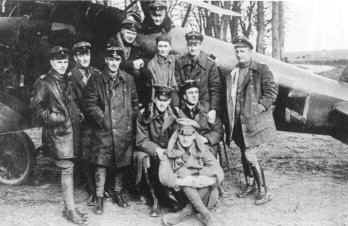 1918
1918
April: Richthofen achieves two victories flying Fokker Dr.1 triplane (number 425/17).
Though he flew biplanes for nearly all of his career, and most of these were only partly
painted red, it is the Dr.1 triplane, blood-red from cowl to tail, which is commonly
associated with the Red Baron.
On April 21, Richthofen followed the Sopwith Camel of Wilfred May far into British
territory. The end of the war was only months off by this time, and the Germain air
command faced both ever-improving British airplanes and their own dwindling numbers. The
thrill of the hunt was all but gone for Baron von Richthofen, as most of his peers had
already been killed and his own wounds agonized him. Though the German air doctrine he
himself wrote stated that "one should never obstinately stay with an opponent which,
through bad shooting or skillful turning, he has been unable to shoot down while the
battle lasts until it is far on the other side", he chased his British quarry far
deeper into enemy territory and far lower to the ground than his own doctrine permitted.
May later said that it was only his erratic, untrained piloting which saved him.
He followed the erratic path of the novice pilot until a single bullet, shot from behind
him, passed diagonally through his chest. The shot is commonly believed to have come from
Australian gunners on the ground, but might have also come from the guns of Canadian flier
Arthur "Roy" Brown who was coming to May's aid. Manfred von Richthofen crashed
into a field alongside the road from Corbie to Bray. His body was recovered by British
forces, and he was buried with full military honors.
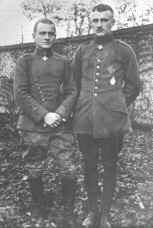 Manfred's brother, Lothar (also a Pour le
Mérite recipient) was himself recovering from being shot down when his older brother was
killed in combat. He returned to Jagdgeschwader 1 and carried on the Richthofen tradition
of fearlessness in combat in a blood-red fighter. Lothar was shot down again on August
13th, 1918, and forced into retirement with 40 kills. Manfred's eventual successor was
Hermann Göring, who chose to paint his aircraft all-white, ending the reign of the
blood-red German fighers
Manfred's brother, Lothar (also a Pour le
Mérite recipient) was himself recovering from being shot down when his older brother was
killed in combat. He returned to Jagdgeschwader 1 and carried on the Richthofen tradition
of fearlessness in combat in a blood-red fighter. Lothar was shot down again on August
13th, 1918, and forced into retirement with 40 kills. Manfred's eventual successor was
Hermann Göring, who chose to paint his aircraft all-white, ending the reign of the
blood-red German fighers
Manfred (L) and Lothar
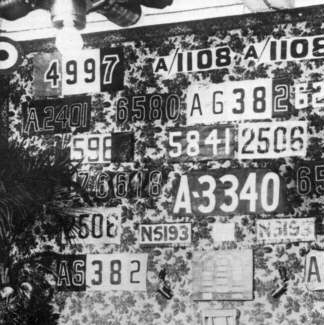
Serial numbers von Richthofen cut off his victims planes
Victories of Manfred von Richthofen
| 09/17/1916 | F.E.2b |
| 09/23/1916 | Bombardér |
| 09/30/1916 | F.E.2b |
| 10/07/1916 | Bombardér |
| 10/16/1916 | Bombardér |
| 10/25/1916 | Bombardér |
| 11/03/1916 | F.E.2b |
| 11/09/1916 | B.E.2 |
| 11/20/1916 | B.E.2 / F.E.2b |
| 11/23/1916 | D H 2 |
| 12/11/1916 | D.H.2 |
| 12/20/1916 | D.H.2 / F.E.2b |
| 12/27/1916 | F.E.2b |
| 01/04/1917 | Sopwith Pup |
| 01/23/1917 | Bombardér |
| 01/24/1917 | F.E.2b |
| 02/01/1917 | B.E.2 |
| 02/14/1917 | (2) B.E.2 |
| 03/04/1917 | B.E.2 / Sopwith Pup |
| 03/06/1917 | B.E.2 |
| 03/09/1917 | D.H.2 |
| 03/11/1917 | B.E.2 |
| 03/17/1917 | B.E.2 / F.E.2b |
| 03/21/1917 | B.E.2 |
| 03/24/1917 | Spad VII |
| 03/25/1917 | Nieuport 17 |
| 04/02/1917 | B.E.2 / Sopwith Strutter |
| 04/03/1917 | F.E.2b |
| 04/05/1917 | (2) Bristol Fighter |
| 04/07/1917 | Nieuport 17 |
| 04/08/1917 | B.E.2 / Sopwith Strutter |
| 04/11/1917 | B.E.2 |
| 04/13/1917 | (2) F.E.2b / R.E.8 |
| 04/14/1917 | Nieuport 17 |
| 04/16/1917 | B.E.2 |
| 04/22/1917 | F.E.2b |
| 04/23/1917 | B.E.2 |
| 04/28/1917 | B.E.2 |
| 04/29/1917 | Nieuport 17 / SpadVII / B.E.2 / F.E.2b |
| 06/18/1917 | R.E.8 |
| 06/23/1917 | Spad VII |
| 06/24/1917 | Airco DH.4 |
| 06/25/1917 | R.E.8 |
| 07/02/1917 | R.E.8 |
| 08/16/1917 | Stíhací letoun |
| 08/26/1917 | Spad VII |
| 09/01/1917 | R.E.8 |
| 09/03/1917 | Sopwith Pup |
| 11/23/1917 | Stíhací letoun |
| 11/30/1917 | S.E.5a |
| 03/12/18 | Bristol Fighter |
| 03/13/18 | Sopwith Camel |
| 03/18/18 | Sopwith Camel |
| 03/24/1918 | S.E.5a |
| 03/25/1918 | Sopwith Camel |
| 03/26/1918 | R.E.8 |
| 03/26/1918 | Sopwith Camel |
| 03/27/1918 | Stíhací letoun |
| 03/27/1918 | Sopwith Camel |
| 03/27/1918 | Airco DH.4 |
| 03/28/1918 | Bombardér |
| 04/02/1918 | R.E.8 |
| 04/06/1918 | Sopwith Camel |
| 04/07/1918 | Spad VII |
| 04/07/1918 | S.E.5a |
| 04/20/1918 | Sopwith Camel |
| 04/20/1918 | Sopwith Camel |
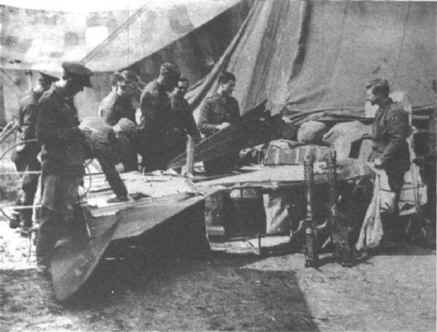
The Allies pick over the wrekage of von Richthofen's Fokker Dr.1
Der
Rote Kampfflieger |
|
My Family |
|
The Outbreak of War |
|
Boredom before Verdun |
|
In the Air |
|
My First solo Flight |
|
I Fly in a Thunder Storm |
|
Bombing in Russia |
|
My First English Victim |
|
I get the Ordre le Merite |
|
A Flying Man's Adventure |
|
| Chapter 11 | My Record Day |
| Chapter 12 | Schafer Lands Between the Lines |
| Chapter 13 | My Brother |